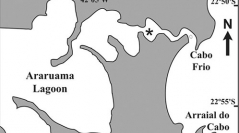

 Cryptogamie, Algologie
26 (4) - Pages 355-371
Cryptogamie, Algologie
26 (4) - Pages 355-371Araruama Lagoon is a coastal hypersaline environment in Southeastern Brazil with a tropical climate.The Lagoon is connected to the sea by a single narrow channel, near which fluctuations in salinity occur over a wide range. Total tissue nitrogen and phosphorus of Acanthophora spicifera, Chaetomorpha crassa, Derbesia vaucheriaeformis, Gracilaria cervicornis, Gracilariopsis tenuifrons, Hypnea valentiae, Rhizoclonium africanum, and Ulva lactuca from the transient environment between the Lagoon and the sea were analysed during two seasonal cycles, from autumn 1997 to autumn 1999. Almost all species showed great variations in the N, P and N:P values over the period. Similar patterns of seasonal fluctuations of tissue N and P during the two years of sampling were found, suggesting the occurrence of common cyclic annual variations. Mean percentages of tissue nitrogen (calculated from data of all species combined) attained maximum values in autumn and minimum in spring, varying from 3.25% to 4.80% of the dry weight (d.w.). Peaks of tissue phosphorus did not coincide with N peaks; maximum mean values of tissue P were obtained in summer (ca 0.40% of d.w.) and minimum values in spring (ca 0.24% of d.w.). During autumn, winter and spring mean atomic N:P ratios were around 30:1, while the summer values were significantly lower (19.2:1 and 23.9:1 in 1998 and 1999, respectively). The analysis of dissolved nutrients showed low concentrations of inorganic phosphorus (except in summer), agreeing with the predominance of the relatively high N:P ratios measured in the tissues. The shallow waters of the sampling site show characteristics of an oligotrophic to mesotrophic environment, and despite ongoing eutrophication levels of dissolved phosphorus seem to control increments in macroalgal biomass.